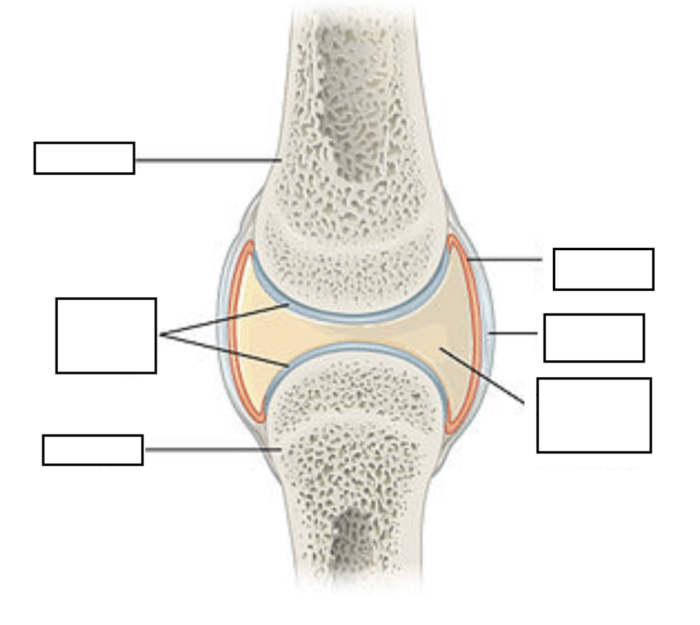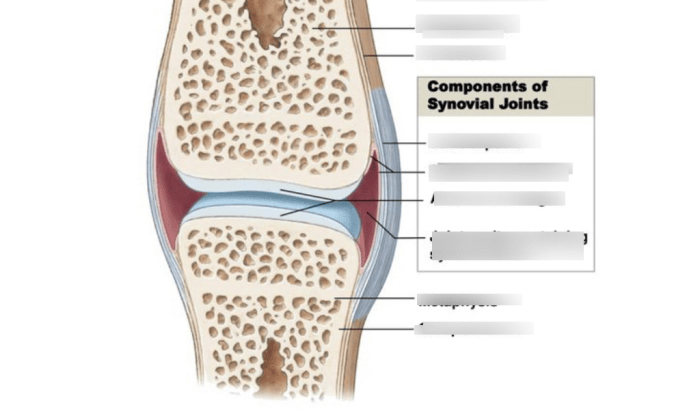Drag the labels to identify synovial joints. Embark on an interactive journey through the fascinating world of synovial joints, the cornerstone of our body’s movement and flexibility. This comprehensive guide unveils the intricate structures, diverse classifications, and clinical significance of these remarkable joints, empowering you with a deeper understanding of human anatomy.
Synovial joints, characterized by their smooth, gliding surfaces and fluid-filled cavities, play a vital role in our everyday activities, from walking and running to reaching and grasping. Dive into the intricacies of their anatomy, unraveling the secrets of the synovial membrane, articular cartilage, and synovial fluid, the key components that orchestrate joint function.
1. Define Synovial Joints

Synovial joints, the most common type of joint in the human body, are freely movable joints characterized by the presence of a synovial membrane, articular cartilage, and synovial fluid. These joints allow for a wide range of movements, including flexion, extension, rotation, and circumduction.
2. Identify Synovial Joint Structures

Synovial Membrane
The synovial membrane lines the joint cavity and produces synovial fluid, which lubricates and nourishes the joint. It also contains specialized cells that secrete nutrients and remove waste products.
Articular Cartilage
Articular cartilage covers the ends of the bones at the joint and provides a smooth, gliding surface for movement. It is composed of specialized cells called chondrocytes, which produce and maintain the cartilage matrix.
Synovial Fluid
Synovial fluid is a viscous liquid that fills the joint cavity. It provides lubrication, nutrition, and shock absorption for the joint.
3. Classify Synovial Joints: Drag The Labels To Identify Synovial Joints.
Types of Synovial Joints Based on Shape
- Plane joints: Flat surfaces that allow for gliding movements (e.g., joints between the vertebrae)
- Hinge joints: Cylindrical surfaces that allow for flexion and extension (e.g., knee joint)
- Pivot joints: Cone-shaped surfaces that allow for rotation (e.g., joint between the radius and ulna)
- Saddle joints: Saddle-shaped surfaces that allow for a combination of movements (e.g., joint between the thumb and trapezium)
- Ball-and-socket joints: Spherical surfaces that allow for a wide range of movements (e.g., shoulder joint)
Factors Determining Range of Motion, Drag the labels to identify synovial joints.
- Shape of the joint surfaces
- Ligaments and tendons surrounding the joint
- Muscle strength and flexibility
- Flexion: Bending a joint
- Extension: Straightening a joint
- Rotation: Turning a joint
- Circumduction: Moving a joint in a circular motion
- Abduction: Moving a limb away from the midline of the body
- Adduction: Moving a limb towards the midline of the body
- Arthritis: Inflammation of the synovial membrane
- Tendonitis: Inflammation of the tendons
- Ligament sprains: Tearing of the ligaments
- Joint dislocations: Displacement of the bones at a joint
- Physical examination: Examination of the joint for swelling, tenderness, and range of motion
- X-rays: Imaging technique to visualize the bones and joint structures
- Magnetic resonance imaging (MRI): Imaging technique to visualize the soft tissues of the joint
- Conservative treatment: Rest, ice, compression, and elevation (RICE); physical therapy; medications
- Surgical treatment: Arthroscopy (minimally invasive surgery); joint replacement
4. Analyze Joint Motion

Types of Joint Movements
Role of Muscles, Ligaments, and Tendons
Muscles generate the force necessary for joint movement. Ligaments and tendons stabilize and reinforce the joint, preventing excessive movement and dislocation.
Importance of Joint Stability and Flexibility
Joint stability ensures that the joint remains in its proper position during movement. Joint flexibility allows for a wide range of movements and prevents stiffness.
5. Clinical Significance of Synovial Joints

Common Injuries and Disorders
Diagnostic Techniques
Treatment Options
Essential FAQs
What distinguishes synovial joints from other joint types?
Synovial joints are distinguished by their freely movable, smooth articular surfaces lined with a synovial membrane, which secretes synovial fluid to reduce friction and provide nourishment.
What are the main types of synovial joints?
Synovial joints are classified based on their shape and movement capabilities into six main types: ball-and-socket, hinge, pivot, condyloid, saddle, and plane joints.
What factors influence the range of motion in synovial joints?
The range of motion in synovial joints is determined by the joint’s shape, the surrounding ligaments and muscles, and the presence of any joint capsule or other structures.
